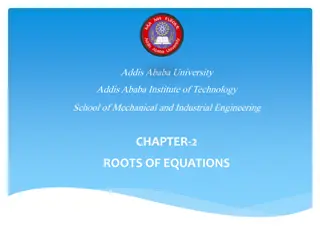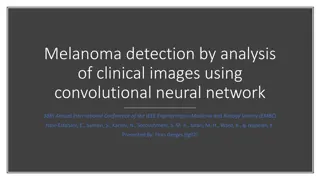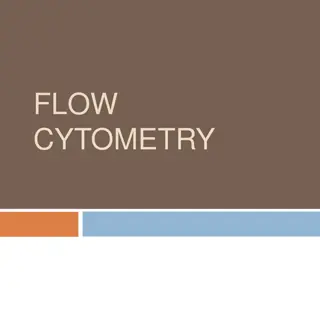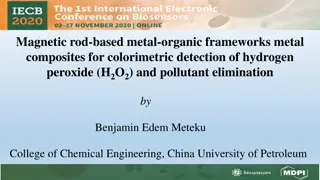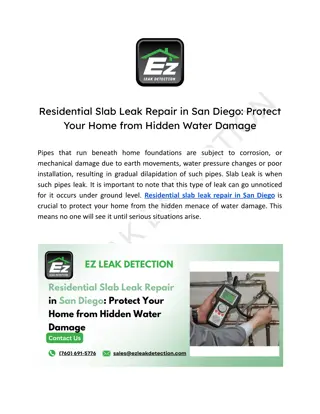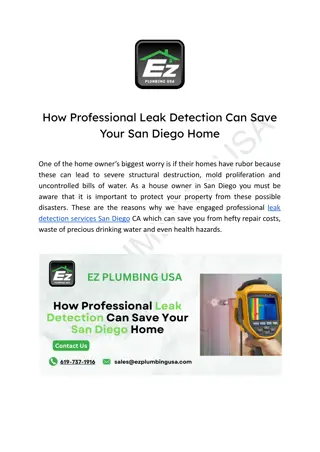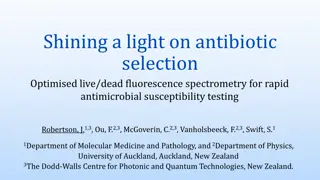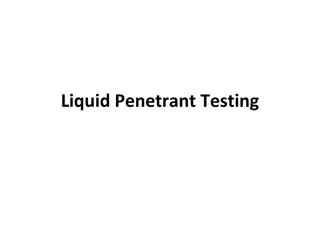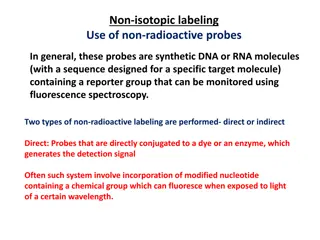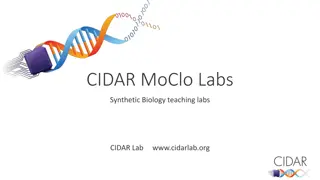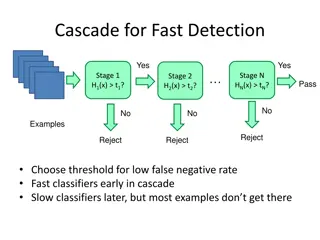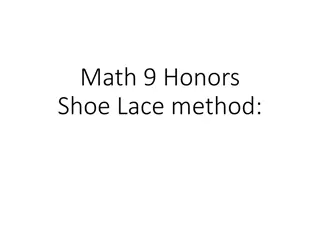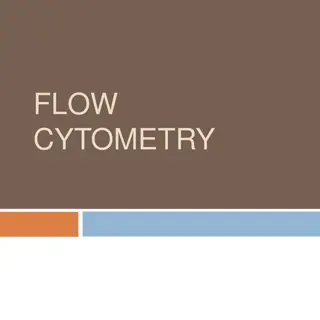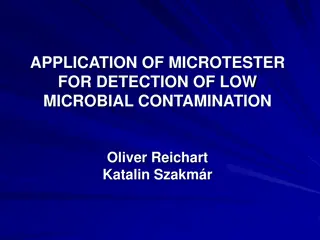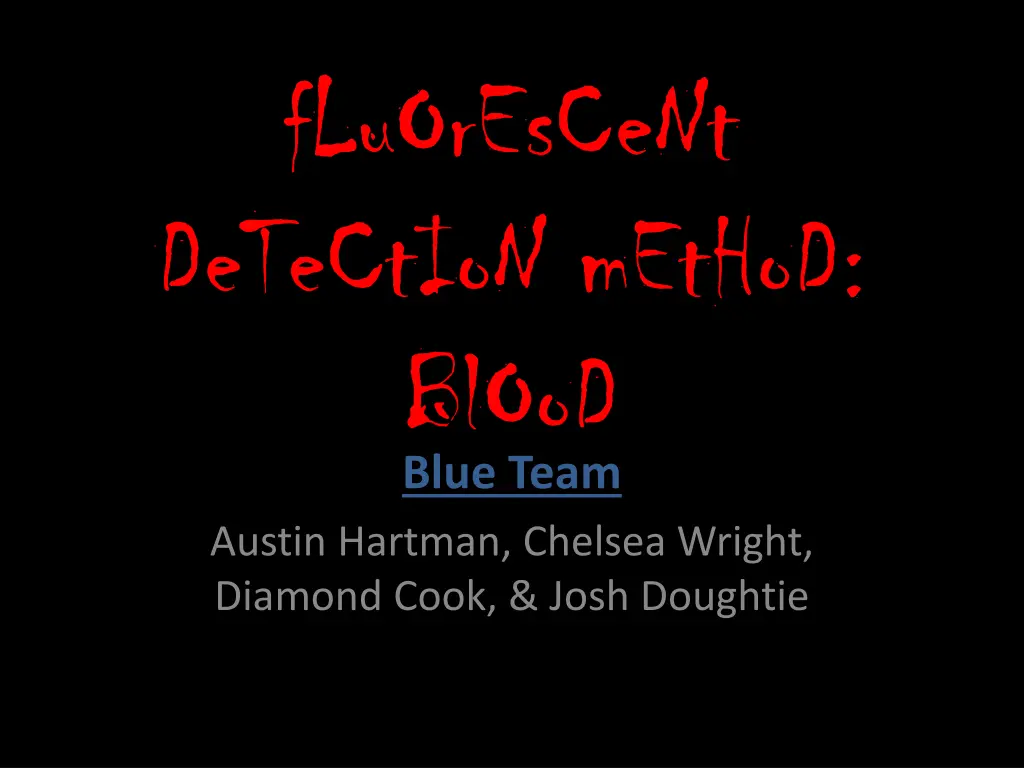
Fluorescent Detection Method in Blood Analysis by Blue Team
Explore the Fluorescent Detection Method in Blood Analysis by Blue Team consisting of Austin Hartman, Chelsea Wright, Diamond Cook, and Josh Doughtie. Learn about the excitation and emission spectra, the light source and detector used, an example output from an HPLC chromatogram, evaluation of potential interferences, and its application in forensic science laboratories for drug detection. Discover how this method helps quantify Phenylalanine and Tyrosine concentrations efficiently.
Download Presentation

Please find below an Image/Link to download the presentation.
The content on the website is provided AS IS for your information and personal use only. It may not be sold, licensed, or shared on other websites without obtaining consent from the author. If you encounter any issues during the download, it is possible that the publisher has removed the file from their server.
You are allowed to download the files provided on this website for personal or commercial use, subject to the condition that they are used lawfully. All files are the property of their respective owners.
The content on the website is provided AS IS for your information and personal use only. It may not be sold, licensed, or shared on other websites without obtaining consent from the author.
E N D
Presentation Transcript
fLuOrEsCeNt DeTeCtIoN mEtHoD: BlOoD Blue Team Austin Hartman, Chelsea Wright, Diamond Cook, & Josh Doughtie
#1: Describe the excitation & emission spectra of the target Optimum response of Phenylalanine, Tyrosine and internal standard was observed when the excitation and emission wavelengths were set at 260 and 282 nm, respectively. The amount of Phe and Tyr was quantified from a peak area ratio of Phe orTyr/internal standard using Clarity chromatography software (DataApex, Prague, Czech Republic)
#2. Describe the light source used to excite the target and the detector used By using a High-performance liquid Chromatograph, along with a solvent delivery system, auto sampler, column oven, RF 10Axl fluorescence detector and SLC-10Avp system controller; researchers were able to excite the Phenylalanine, and Tyrosine solutions. Data was collected digitally with Clarity chromatography software. The concentrations of Phenylalanine and Tyrosine in the samples were determined from the calibration curve (R. Kand r , P. Z kov ). In layman s terms: lasers are used the light source.
#3. Provide an example of the output An HPLC chromatogram of Phe (74.8_mol/L) and Tyr (40.9_mol/L) in a dried blood sample. Tyr (3.2 min), Phe (6.0 min), N-methyl-Phe internal standard (6.7 min). HPLC conditions: an isocratic elution (mobile phase: 5% ethanol in deionized water); stationary phase were a column LiChroCART 125mm 4mmi.d., Purospher STAR RP-18e, 5_m and a guard column LiChroCART 4mm 4mm i.d., Purospher STAR RP-18e, 5_m (Merck KgaA, Darmstadt, Germany). The flow rate was kept constant at 0.5 mL/min, the separation ran at 37 C and Phe, Tyr, and Nmethyl- Phe were monitored at excitation and emission wavelengths of 260 and 282 nm, respectively.
#4. Describe any problems or need to optimize detection (interferences?) From what has been read and researched, there are no reported major flaws to this fluorescent detection method. This article and others that were looked at to verify flaws, never stated there were any interferences.
#5. Describe how it is used in #5. Describe how it is used in forensic science laboratories. forensic science laboratories. HPLC with fluorescence is used in Forensic toxicology. Forensic labs use this method to detect drugs in the hair and blood, the most common group are methamphetamines. They use fluorescent reagents, such as 4-(4,5-diphenyl-1H-imidazol-2-yl)benzoyl chloride or DIB-CL for short, which react with compounds having a primary or secondary amino group and phenol group. Unlike other types of drug detection techniques (I.e gas chromatography), HPLC with fluorescence only require a small amount of blood or plasma in order to detect. Other sources: Http://onlinelibrary.wiley.com/doi/10.1002/bmc.716/pd f
#6. Describe the #6. Describe the instruments used in your instruments used in your applications applications Liquid Chromatograph: Separates mixture of compounds, it is used to identify, quantify, and purify the individual components of a mixture.
Scholarly Article Scholarly Article http://www.sciencedirect.com.libaccess.sjlibra ry.org/science?_ob=ArticleURL&_udi=B6X0P- 4XDD06H- 3&_user=521825&_coverDate=11/15/2009&_ rdoc=1&_fmt=high&_orig=search&_origin=se arch&_sort=d&_docanchor=&view=c&_acct=C 000059578&_version=1&_urlVersion=0&_use rid=521825&md5=848d6a5eeec7876ac57030 23883ee6fa&searchtype=a


